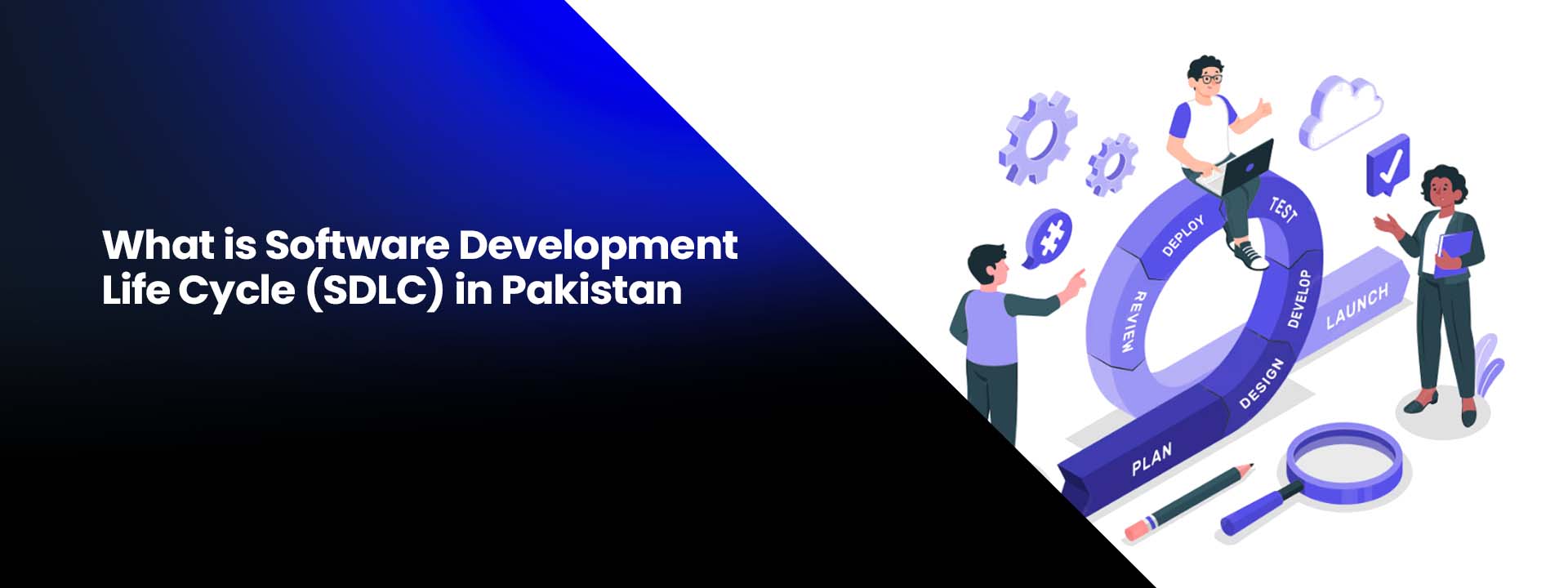What is Software Development Life Cycle (SDLC) in Pakistan
Published on: 30 October, 2025

The Software Development Life Cycle (SDLC) is a structured process used by developers to design, develop, test, and deploy software applications effectively. It ensures that software meets client expectations, functions properly, and stays within budget. Understanding the steps for software development life cycle helps software companies in karachi and developers achieve consistent results and maintain high-quality standards.
In Pakistan’s growing tech ecosystem, businesses are increasingly adopting different software development life cycle models pdf formats to streamline their projects. Whether a startup in Lahore or a large digital marketing company in pakistan, following a systematic SDLC process leads to better products and happier clients.
Understanding the Concept of SDLC
The Software Development Life Cycle is a series of stages that guide teams through the entire software creation process — from planning to deployment and maintenance. Each phase plays a vital role in ensuring the software meets the customer’s needs.
SDLC offers a disciplined approach to development. By breaking down complex processes into manageable steps, it reduces risks and enhances productivity. In Pakistan, software companies such as NetSol, Systems Limited, and progressive solution rely heavily on SDLC frameworks to ensure project success and scalability.
Importance of SDLC in Pakistan’s IT Industry
Pakistan’s software industry is expanding rapidly, and with it, the need for structured development methodologies. SDLC ensures that every stage of development aligns with project goals and client expectations.
- It provides a clear roadmap for developers and stakeholders.
- It ensures timely delivery and quality assurance through systematic stages.
In a competitive market like Pakistan, businesses that follow SDLC benefit from increased efficiency, fewer errors, and improved communication between website development in karachi teams and clients. This structured process also ensures compliance with international standards like ISO and CMMI.
Steps for Software Development Life Cycle
The steps for software development life cycle are designed to provide a clear direction for teams. These steps include:
- Planning: Define project scope, resources, and goals.
- Feasibility Study: Analyze cost, technical viability, and risk factors.
- Design: Create architecture and design models.
- Development: Write and compile the actual code.
- Testing: Identify and fix bugs or errors.
- Deployment: Launch the software for real-world use.
- Maintenance: Continuously improve and update the system.
Each of these stages ensures that the project moves from concept to completion in a structured, efficient, and measurable way.
Different Software Development Life Cycle Models
Various different software development life cycle models exist to suit diverse project needs. Some of the most popular ones used in Pakistan include:
- Waterfall Model: A sequential approach where each phase must be completed before the next begins.
- Agile Model: What Is Agile Methodology in Software Development: A Streamlined Approach from Pakistan — a modern, iterative model focused on collaboration, flexibility, and rapid delivery.
- V-Model (Verification and Validation): Focuses on testing and quality at every stage.
- Spiral Model: Combines iterative and risk-driven approaches for large projects.
In practice, many Pakistani software houses prefer Agile and Hybrid models to accommodate changing client requirements and rapid product delivery.
Agile Software Development Life Cycle Phases
The Agile software development life cycle phases prioritize collaboration, flexibility, and customer feedback. Instead of rigid stages, Agile divides work into small sprints, allowing continuous improvement.
Each sprint includes planning, development, testing, and review. Agile works exceptionally well for startups and businesses in Pakistan that frequently update their software or need to adapt to fast-changing markets. It promotes faster feedback loops, enabling developers to deliver functional products more quickly.
Software Development Life Cycle Design Phase
One of the most critical stages in SDLC is the software development life cycle design phase. During this phase, architects and developers create the blueprint for the software, including its interface, data flow, and system architecture.
This stage determines how the software will perform and interact with users. Proper design reduces future issues and ensures smooth functionality. Pakistani companies often use modern tools like Figma, UML diagrams, and ER models to visualize the design before starting actual development.
Secure Software Development Life Cycle Processes
In today’s digital landscape, secure software development life cycle processes are more important than ever. Security is no longer an afterthought but an integrated part of every SDLC stage.
Pakistani developers increasingly adopt security frameworks like OWASP to embed safety in every phase — from design to deployment. This helps protect sensitive data, prevent breaches, and ensure compliance with privacy laws such as GDPR and Pakistan’s Personal Data Protection Bill.
Companies integrating secure SDLC processes gain a competitive edge by delivering not only functional but also safe and reliable software.
Benefits of Software Development Life Cycle
The benefits of software development life cycle are far-reaching, especially for companies operating in Pakistan’s tech-driven economy. It ensures structure, consistency, and accountability across the entire development process.
Key benefits include:
- Predictable outcomes: Defined stages make progress measurable.
- Reduced risk: Early problem detection prevents costly errors later.
- Quality assurance: Testing at multiple stages ensures reliability.
By following SDLC, Pakistani software firms can reduce project delays, improve collaboration, and deliver better ROI for their clients.
Software Development Life Cycle Example
To better understand the SDLC in action, let’s consider a software development life cycle example. Suppose a Lahore-based company wants to create a mobile banking app.
- Planning: Define user needs like fund transfers and balance checks.
- Design: Create wireframes for user interfaces.
- Development: Write backend APIs and mobile app code.
- Testing: Ensure transaction security and bug-free experience.
- Deployment: Launch the app for users.
- Maintenance: Release updates and monitor performance.
This example shows how SDLC ensures a clear roadmap from idea to product launch, minimizing confusion and maximizing efficiency.
The Future of SDLC in Pakistan
As Pakistan’s IT export industry grows beyond $3 billion annually, the importance of SDLC is only increasing. With international clients demanding quality and transparency, adopting global SDLC standards has become essential.
From Agile to DevOps integrations, Pakistani developers are blending traditional models with modern practices for speed and innovation. The rise of AI, blockchain, and cloud-based tools will further revolutionize the SDLC approach in the coming years, ensuring Pakistani developers stay globally competitive.
To Wrap Things Up
The Software Development Life Cycle (SDLC) is the backbone of successful software engineering. It helps teams create reliable, secure, and scalable applications while maintaining quality and efficiency.In Pakistan, where the IT sector continues to thrive, mastering SDLC principles ensures local companies meet global standards and deliver world-class software solutions. Whether you’re a developer, project manager, or seo services provider in karachi,
FAQ’s
1. What exactly is the Software Development Life Cycle (SDLC)?
Building software follows clear steps – from idea to design, then coding, checking, release, plus upkeep. Companies like AWS or Atlassian use this path to build solid products step by step. This method lets groups create reliable apps steadily, tracking progress clearly along the way.
2. What’s the point of following an SDLC for companies or dev groups?
Because without a defined lifecycle process you risk scope creep, budget overruns, frequent defects and delayed releases. phoenix NAP | Global IT Services+1 By following SDLC phases you improve planning, stakeholder alignment, quality assurance and cost control.
3. What steps usually show up in a software development cycle?
Though models differ, many follow steps such as: Planning → Checking Needs → Building a Plan → Writing Code → Trying It Out → Rolling It Live → Keeping It Running. Tools from Harness.io along with Atlassian help here. Every step aims at something unique and produces clear results.
4. How do different SDLC models (e.g., Waterfall, Agile, DevOps) affect the lifecycle approach?
Different models set up the same SDLC steps in their own way:
- In Waterfall, stages follow one after another – fixed, unchanging.
- In Agile or DevOps-infused SDLCs, phases overlap, iterate, and feedback cycles are frequent. phoenixNAP | Global IT Services+1 Choosing the right model depends on project size, risk tolerance, flexibility and team maturity.
5. What ought a company boss or team leader keep an eye on when rolling out SDLC without hiccups?
Clear needs set the stage – support from everyone involved keeps things moving. Docs that stay up to date make life easier down the line, while testing from day one catches issues before they grow. Handling risks smartly matters just as much as planning for upkeep later on. Picking an SDLC approach that fits your situation? That’s half the battle. Throw in team alignment and steady tracking, then watch how smoothly it all runs. TestLodge Blog+1 Each piece adds up to getting the most out of the process.




